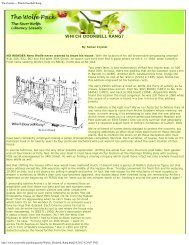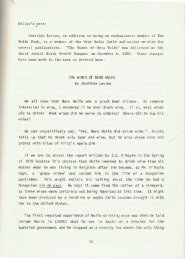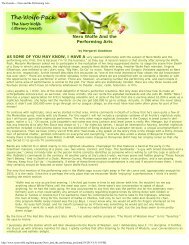Orchids: An Illustrated Ref. by Michael Bishop - Wolfe Pack
Orchids: An Illustrated Ref. by Michael Bishop - Wolfe Pack
Orchids: An Illustrated Ref. by Michael Bishop - Wolfe Pack
Create successful ePaper yourself
Turn your PDF publications into a flip-book with our unique Google optimized e-Paper software.
BEST IF VIEWED IN ADOBE READER RATHER THAN YOUR BROWSER<br />
SO THE BOOKMARKS FOR THE 120 PAGES WILL DISPLAY FOR YOU.<br />
In Google Chrome, to save the file to your hard drive, click the diskette icon<br />
(2 nd from the right), then open with Adobe Reader.<br />
In Internet Explorer click the Adobe icon (far right)<br />
In Mozilla Firefox, click the “Open With Different Viewer” button<br />
on the top right of the screen.
Libra Pictura<br />
Nero <strong>Wolfe</strong>i<br />
Compiled with reverence <strong>by</strong> <strong>Michael</strong> <strong>Bishop</strong>
Introduction<br />
It started out as a simple idea: Collect a picture of each orchid that is mentioned in one of the Nero <strong>Wolfe</strong><br />
stories.<br />
After all, it would be reasonable to expect that some earlier enthusiast had collated the orchid series, and it<br />
would probably be posted somewhere on the Internet.<br />
Well, indeed, such was the case---sort of.<br />
There are indeed such lists available, three were quickly found, but it was obvious that they had been<br />
compiled with full appreciation of early efforts (errors of commission and omission were repeated) but most<br />
surprising, they were all woefully incomplete!<br />
Accordingly, each and every story was read anew in an attempt to rectify the list.<br />
Next, the Internet was searched for a suitable image of each of the orchids.<br />
<strong>Orchids</strong>, or even flowers in general, appear to be favorites of photographers, so the selection among the many<br />
choices was not easy.<br />
Surprisingly, however, images of all of the orchids named <strong>by</strong> Rex Stout are not to be found. Some are<br />
restricted <strong>by</strong> copyright or electronic transmission filter, some are of very low resolution and make poor copies, and<br />
some appear simply to be figments of Stout’s imagination.<br />
In tracing the records of orchid illustrations, there are indications that there are fads in orchid culture, and<br />
some of the orchids named in the early Nero <strong>Wolfe</strong> stories may simply have fallen out of favor, and so photographs<br />
are not available. Nevertheless, some orchid images have also been captured in drawings or paintings. Others have<br />
appeared on postage stamps or glazed tiles. Examples of these alternative portrayals have been included in the<br />
collection simply for variety and entertainment.<br />
In the libra pictura, each orchid image has the passage from the book where the orchid is mentioned. Only the<br />
chapter citation is given, since the correct page numbers are a function of the edition in which it appears. (There was<br />
a lot of trouble trying to decide what was the appropriate punctuation, spelling, and italicization for the excerpts, so<br />
the sharp-eyed quibblers will have a field day, the rest of us will just enjoy them. <strong>An</strong>d besides, Stout or his editors<br />
and proofreaders were not consistent either. It might even be said that Stout was indifferent, perhaps even cavalier,<br />
toward the proper spelling of orchid names.)<br />
In compiling the collection, a decision was made to include at least one illustration from each one of the<br />
stories, even those that did not have any orchids named. <strong>An</strong>d moreover, some of the more familiar <strong>Wolfe</strong>an artifacts<br />
that appeared regularly are included. (At some point a halt had to be called on the further addition of these<br />
supplements, otherwise the collection would have become a Classic Comic book.)<br />
In each orchid image, if the caption is without parenthesis, the orchid is indeed the one named. If a<br />
parenthesis is included, the actual orchid has not been found, or it is one of Stout’s imaginary ones, so the flower<br />
shown is either of the appropriate type, but a different subtype, or it is one that is just plain pretty. Additions,<br />
corrections, and suggestions are welcomed, again a challenge to the eagle-eyed.<br />
Otherwise, just enjoy the pictures. Happy viewing!
The <strong>Orchids</strong> Of Nero <strong>Wolfe</strong><br />
The complete listing from <strong>Michael</strong> <strong>Bishop</strong><br />
(In chronological book publication order)<br />
I set out to make Julie an album containing a picture of each of the orchids mentioned in the NW<br />
stories. Found out lots of interesting things, such as some possibly imaginary names, erratic<br />
spellings, and lots of other flora names.<br />
<strong>An</strong>yway, one of the most challenging tasks in trying to complete the album was to find a complete<br />
list of the orchids mentioned in the Stout works. So, of course, that meant I had a challenge to do it<br />
up right.<br />
I am sure that some of the more enthusiastic <strong>Wolfe</strong>ans will find it interesting. <strong>An</strong>d of course, I<br />
would like to know if I missed any orchids or made any mistakes.<br />
Fer-de-Lance<br />
<strong>An</strong>graecum sesquipedale<br />
Cattleya dowiana aurea<br />
Cymbidium Alexanderi<br />
Cattleya<br />
Laelia<br />
Odontoglossum<br />
Oncidium<br />
Miltonia<br />
Laeliocattleya Lustre<br />
Brassocattlaelia Truffautiana<br />
Miltonia blueanaeximina<br />
Dendrobium chlorostele<br />
Cymbidium<br />
Dendrobium Melpomene<br />
Dendrobium Findlayanum<br />
The League of Frightened<br />
Men<br />
Cattleya<br />
Odontoglossum<br />
Miltonia<br />
Brassocattlaelia Truffautiana<br />
Dendrobium<br />
The Rubber Band<br />
Oncidium<br />
Cattleya trianae<br />
Odontoglossum<br />
Miltonia<br />
Cattleya<br />
Laelia<br />
Cymbidium<br />
Laeliocattleya Lustre<br />
Laeliocattleya<br />
The Red Box<br />
Coelogyne pandurata<br />
Laeliacattleya luminosa aurea<br />
Cattleya<br />
Too Many Cooks<br />
none<br />
Some Buried Caesar<br />
Paphiopedilum lawrenceanum<br />
hyeanum<br />
Paphiopedilum callosum sanderae<br />
Laeliocattleya<br />
Odontoglossum<br />
Curtains for Three (3)<br />
The Gun With Wings<br />
None<br />
Bullet for One<br />
Zygopetalum<br />
Renanthera<br />
Odontoglossum<br />
Disguise for Murder<br />
Brassocattleya<br />
Laeliocattleya<br />
Miltonia<br />
Odontoglossum<br />
Cattleya dowiana<br />
Dendrobium<br />
Murder <strong>by</strong> the Book<br />
Phalaenopsis<br />
Cattleya<br />
Dendrobium chrysotoxum<br />
Cypripedium Lord Fisher<br />
Dendrobium Cybele<br />
Brassocattleya<br />
Laeliocattleya<br />
Cattleya Dionysius<br />
Cattleya Katadin<br />
Cattleya peetersi<br />
Brassocattleya Calypso<br />
Brassocattleya fournierae<br />
Brassocattleya Nestor<br />
Laeliocattleya barbarossa<br />
Laeliocattleya Carmencita<br />
Laeliocattleya St. Gothard<br />
Oncidium varicosum<br />
Oncidium<br />
Oncidium Forbesi<br />
Cypripedium Minos<br />
Dendrobium<br />
Cochlioda<br />
Triple Jeopardy (3)<br />
Home to Roost<br />
Miltonia<br />
The Cop Killer<br />
none<br />
The Squirt and the Monkey<br />
none<br />
Champagne for One<br />
Coelogyne<br />
Dendrobium<br />
Renanthera<br />
Odontoglossum<br />
Miltonia<br />
Phalaenopsis<br />
Cattleya<br />
Plot It Yourself<br />
Cattleya gaskelliana alba<br />
Cattleya mossiae wageneri<br />
Phalaenopsis Aphrodite<br />
Three at <strong>Wolfe</strong>'s Door (3)<br />
Poison a la Carte<br />
Phalaenopsis Aphrodite<br />
Jack in the Pulpit<br />
Method Three for Murder<br />
none<br />
The Rodeo Murder<br />
none<br />
Too Many Clients<br />
Calanthe veitchi sandhurstiana<br />
Lycaste delicatissima<br />
The Final Deduction<br />
Miltonia vexillaria<br />
Oncidium marshallianum<br />
Dendrobium chrysotoxum<br />
Laelia purpurata<br />
Miltonia roezlii<br />
Homicide Trinity (3)<br />
Eeny Meeny Murder Mo<br />
none<br />
Death of a Demon<br />
Odontoglossum pyramus<br />
Counterfeit for Murder<br />
Miltonia roezlii<br />
Miltonia<br />
Gambit<br />
Laelia gouldiana
Over My Dead Body<br />
Odontoglossum<br />
Dendrobium<br />
Coelogyne<br />
Miltonia<br />
Lycaste<br />
Cattleya<br />
Oncidium<br />
Where There’s a Will<br />
Cattleya Mossiae<br />
Black <strong>Orchids</strong> (2)<br />
Black <strong>Orchids</strong><br />
Brassocattlealia truffautiana<br />
Brassocattlealia thorntoni<br />
Cypripedium pubescens<br />
Cypripedium Fissipes<br />
Cymbidium Miranda<br />
Phalaenopsis<br />
Cattleya hassellis<br />
Cordially Invited to Meet<br />
Death<br />
Vanda<br />
Not Quite Dead Enough (2)<br />
Not Quite Dead Enough<br />
none<br />
Boo<strong>by</strong> Trap<br />
none<br />
The Silent Speaker<br />
Cattleya<br />
Laeliocattleya<br />
Brassocattleya thorntoni<br />
Too Many Women<br />
Miltonia<br />
Phalaenopsis<br />
<strong>An</strong>d Be a Villain<br />
Zygopetalum crinitum<br />
Trouble in Triplicate (3)<br />
Before I Die<br />
Cattleya<br />
Dendrobium<br />
Phalaenopsis<br />
Help Wanted, Male<br />
Cattleya<br />
Instead of Evidence<br />
Dendrobium<br />
The Second Confession<br />
Dendrobium bensoniae<br />
Odontoglossum harryanum<br />
Prisoner’s Base<br />
Cymbidium holfordianum<br />
Cymbidium pauwelsi<br />
The Golden Spiders<br />
Vanda caerulea<br />
Vanda<br />
Brassavola<br />
Miltonia roezlii<br />
Phalaenopsis Aphrodite<br />
Cattleya<br />
Laelia<br />
Miltonia roezlii alba<br />
Three Men Out (3)<br />
Invitation to Murder<br />
none<br />
The Zero Clue<br />
Odontoglossum<br />
Calanthe<br />
This Won’t Kill You<br />
none<br />
The Black Mountain<br />
Laeliocattleya Jaquetta<br />
Dendrobium nobilius<br />
Before Midnight<br />
Cattleya mossiae<br />
Odontoglossum<br />
Phalaenopsis<br />
Cattleya mossiae reineckiana<br />
Oncidium varicosum<br />
Three Witnesses (3)<br />
The Next Witness<br />
none<br />
When a Man Murders<br />
none<br />
Die Like a Dog<br />
none<br />
Might As Well Be Dead<br />
Phalaenopsis stuartiana<br />
Phalaenopsis schilleriana<br />
Three for the Chair (3)<br />
A Window for Death<br />
none<br />
Immune to Murder<br />
none<br />
Too Many Detectives<br />
none<br />
If Death Ever Slept<br />
Cochlioda roezliana<br />
Odontoglossum armainvillierense<br />
The Mother Hunt<br />
Cypripedium lawrenceanum hyeanum<br />
Trio for Blunt Instruments<br />
(3)<br />
Kill Now—Pay Later<br />
none<br />
Murder Is Corny<br />
Dendrobium nobile<br />
Oncidium<br />
Laeliocattleya<br />
Blood Will Tell<br />
Cymbidium Doris<br />
A Right to Die<br />
Miltonia roezlii<br />
Phalaenopsis Aphrodite<br />
Vanda suavis<br />
The Doorbell Rang<br />
Miltonia sanderae<br />
Odontoglossum pyramus<br />
Phalaenopsis Aphrodite<br />
Oncidium flexuosum<br />
Death of a Doxy<br />
Odontoglossum hellemense<br />
Odontoglossum harvengtense<br />
Odontoglossum crispum<br />
Vanda rogersi<br />
Odontoglossum crispo-harryanum<br />
Odontoglossum aireworthi<br />
Miltonia vexillaria<br />
Miltonia roezlii<br />
The Father Hunt<br />
Laelia schroederi<br />
Laelia ashworthiana<br />
Miltonia hellemense<br />
Phalaenopsis Aphrodite<br />
Miltonia charlesworthi<br />
Odontoglossum pyramus<br />
Phalaenopsis Aphrodite sanderiana<br />
Death of a Dude<br />
none<br />
Please Pass the Guilt<br />
Acampe pachyglossa<br />
Peristeria elata<br />
Broughtonia sanguinea<br />
Dendrobium chrysotoxum<br />
A Family Affair<br />
none
Three Doors to Death (3)<br />
Man Alive<br />
None<br />
Omit Flowers<br />
Miltonia roezlii<br />
Door to Death<br />
Odontoglossum cirrhosum<br />
Odontoglossum nobile veitchianum<br />
Phalaenopsis Aphrodite<br />
Phalaenopsis Aphrodite dayana<br />
Phalaenopsis Aphrodite sanderiana<br />
Miltonia<br />
In the Best Families<br />
Miltonia<br />
Phalaenopsis<br />
Vanda peetersiana<br />
<strong>An</strong>d Four to Go (4)<br />
Christmas Party<br />
Odontoglossum<br />
Easter Parade<br />
Vanda<br />
Vanda peetersiana<br />
Vanda sandarae<br />
Cattleya<br />
Calanthe<br />
Phalaenopsis<br />
Fourth of July Picnic<br />
Renanthera imschootiana<br />
Murder Is No Joke<br />
Laelia gouldiana<br />
Death Times Three (3)<br />
Bitter End<br />
none<br />
Frame-up For Murder<br />
(aka Murder Is No Joke)<br />
Vanda<br />
Miltonia<br />
Assault on a Brownstone<br />
(aka Counterfeit Murder)<br />
none
Life Magazine, 15 September, 1963<br />
Why Nero <strong>Wolfe</strong> Likes <strong>Orchids</strong><br />
<strong>by</strong> Archie Goodwin<br />
(with the <strong>by</strong>line of his agent, Rex Stout)<br />
When people ask me why Nero <strong>Wolfe</strong> grows orchids I ask them which they are interested in orchids or him. If<br />
they ask what difference that makes, I say it makes all the difference. If they are curious about orchids, the best and<br />
simplest answer is to take them up to the plant rooms, but if they’re curious about Nero <strong>Wolfe</strong>, there are a dozen<br />
different answers and they are all complicated.<br />
<strong>Wolfe</strong>’s flowers go all the way from the showiest to the shyest. He has a Cattleya<br />
hybrid, bred <strong>by</strong> him, which threw its’ first flower last year,<br />
that is twice as gaudy, as anything you ever you ever saw in<br />
a florist shop, and he has a Cymbidium hybrid, ensifolium<br />
x Sanderae, bred <strong>by</strong> him in 1953, so coy that it makes one<br />
little flower each year – off-white, the size of a dime,<br />
hidden down in the foliage. Once I saw him scowling at it<br />
and muttering, “Confound you, are you too timid or too<br />
proud?”<br />
If he ever talks to himself he keeps it strictly private, but I<br />
have heard him talk to orchids. He’ll cock his head at a bench of Miltonias in full bloom<br />
and say distinctly, “Much too loud. Why don’t you learn to<br />
whisper?” Not that he ever whispers.<br />
<strong>Wolfe</strong> started on orchids many years ago with a specimen<br />
plant of Vanda suavis, given to him <strong>by</strong> the wife of a man he<br />
had cleared of a murder rap. He kept it in the office and it<br />
petered out. He got mad, built a shed on the roof and<br />
bought 20 plants. Now the plant rooms are 34x86, the size<br />
of the house. He hasn’t bought a plant from a commercial<br />
grower for 10 years, but he sells some – a hundred or more<br />
a year.<br />
Of the four hours a day he spends up in the plants rooms – 9 to 11 in the morning and 4 to 6 in the afternoon –<br />
not more than 20 minutes is spent looking at the flowers. First he makes a tour through the<br />
aisles,, which are 30 inches wide instead of the usual two feet – the tropical room, the<br />
intermediate, and the cool – and then on to the potting room. He nods to Theodore, the<br />
gardener, and says, “Well?” Theodore says either, “Well enough,” or<br />
something like, “ A pod of Coelogyne will be ready in two days,”<br />
Then work. It may be real work, like bringing a dozen old plants from<br />
one of the rooms for dividing and repotting, or opening a bale of<br />
osmunda fiber and inspecting it; or it may be merely getting a tape and<br />
going to the cool room to measure the panicles of Odontoglossums. It<br />
can be any of a thousand chores that orchids take – mixing fertilizer, labeling, presoaking new<br />
pots, checking ventilation and humidity, adjusting shade screens, stripping bulb sheaths, chipping<br />
charcoal, and so forth, forever and ever with no amen. Except spraying. <strong>Wolfe</strong> hates it, and<br />
Theodore does it when he is not there.<br />
Of course, most of the chores are for breeding, not growing. Buying a dozen or so orchid plants and<br />
keeping them going and blooming in a house or apartment is no trick at all, but hybridizing is a career. Usually<br />
an orchid flower is both male and female, so deciding on father and mother is up to Nero <strong>Wolfe</strong>. Having crosspollinated,<br />
he waits seven months to a year for the seedpod to mature and ripen. A large pod will have a million or more
seeds. They are among the smallest of all plant seeds.<br />
The preparations in a hospital operating room for an appendectomy are nothing compared to the fuss of planting a batch<br />
of orchid seed. What <strong>Wolfe</strong> has to keep out is fungus. If one microscopic fungus cell gets in a bottle with the seed, it<br />
goes to work on the nutrient jelly in which the infant flower is planted, and good<strong>by</strong>e seed. If he does it right and is lucky<br />
in 9 or 10 months he scoops the tiny half-inch seedlings out of the bottle and plants them in community pots. A year later<br />
he transplants them to individual three-inch pots an in another two years to 41/2-inch pots, and crosses his fingers. Then<br />
five or six or seven years since the day he put pollen to stigma, he sees an orchid no one ever saw before. It is different<br />
from any orchid that has ever bloomed, including those in the Garden of Eden. The differences may be very slight, or<br />
there may be flaws, but about once in every five times his orchid will be worth of dad and mom, and there is one chance<br />
in a thousand that it will be an absolute stunner. Since he has seen only a fraction of the many thousands of named and<br />
listed hybrids, he can’t be sure until the day some grower takes a long hard look at his ba<strong>by</strong> and says casually,<br />
“Interesting little plant. I’ll give you $400 for it.” Then he’ll know that in a few years orchid catalogues will list one<br />
more named for him, or at least <strong>by</strong> him.<br />
In the past 20 years Nero <strong>Wolfe</strong> has had that<br />
happen 14 times, and he has on his benches a total of 112<br />
unnamed varieties bred <strong>by</strong> him and good enough to keep.<br />
Okay, that’s very satisfactory, and it’s one of the reasons he<br />
grows orchids; but it’s not the main one. He grows orchids<br />
chiefly for the same reason that he wears bright yellow<br />
shirts: for the color.<br />
I said he spends only 20 minutes of the four hours looking at the flowers, but that’s a lot.<br />
<strong>An</strong>yway he get some special kick from color. He says you don’t look at color, you feel it,<br />
and apparently he thinks that really means something.<br />
It doesn’t to me, but maybe it does to you and you know exactly how he feels as<br />
he opens the door to the plant rooms and walks in on the big show. I have never known a<br />
day when less than a hundred plants were in bloom, and sometimes there are a thousand,<br />
from the pure white of dainty little Dendrobium nobile<br />
virginalis to the yellow-tan-bronze-mahogany-purple of big<br />
and gangly Laelia tenebrosa. It is unquestionably work a look<br />
– or if you react the same way <strong>Wolfe</strong> does, a feel.<br />
One question I don’t know the answer to and can only<br />
guess at is why he cuts the ones he brings down to the office every<br />
morning for the vase on his desk. Why not bring the plant, since<br />
then the flowers would be good for another week or more?<br />
Because he would have to take back up again? No; he could just<br />
add that to my daily chores. Because he thinks that particular spike<br />
or raceme has been around long enough? No; sometimes it will be<br />
a very special item, like the dwarf Vanda with green dots that a commercial grower offered<br />
him $1,200 for. Because he hates to carry things? That could be, but he carries plenty of them<br />
from the growing rooms to the potting rooms and back again. The best guess is that he doesn’t<br />
want to give a plant a shadow of an excuse not to go on blossoming at peak efficiency. If a Zygopetalum has a cluster of<br />
eight flowers this year, and next year only six, it could blame it on a day in the office – not enough light and temperature<br />
and humidity wrong, and although you can say pfui to an orchid plant, and <strong>Wolfe</strong> often does, there’s no real satisfaction<br />
in it.<br />
How does he decide each morning which one he will cut for his desk that day? I have had various theories, but<br />
none of them have stood up. One was that it depended on the bank balance. If the balance was high, say 50 grand, he<br />
would pick something extra flashy, it was low, down to four figures, it would be something subdued like a brown<br />
speckled Dendrobium. That theory lasted three days. When I told him about it he grunted and said,” The flower a woman<br />
chooses depends on the woman. The flower a man chooses depends on the flower.”









